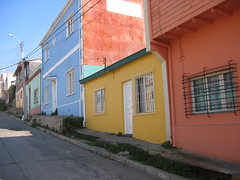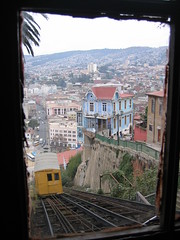Valpo, Chile
4 July 2006
3:28 PM
Chileans call their city Valparaíso “patrimonio de humanidad,” a national treasure that belongs to the world. Technically, they are correct. In 2003, UNESCO declared the historic quarter of the city to be a world heritage site. If you visit Valparaíso, you won’t need long to understand why. Arrive by day and you’ll see the vibrantly colored houses that paint its hills; arrive by night and you’ll see the sparkling lights that illuminate its harbor. In either case, you should stay for a couple days to let the city’s charm rub off on you.
Valparaíso, known affectionately as Valpo by locals, is unique in the spectrum of Chilean cities because it’s worth visiting for its own sake. This is more than can be said for many Chilean cities. Concepción, Temuco, Antofagasta, and even capital Santiago are rather drab populations centers. Visitors get the impression that they were built for work, not play. Valparaíso was, and continues to be, a working city. It’s a port city—Chile’s second largest—and carries some unfortunate baggage associated with that. But unlike its fellow cities, Valparaíso retains a playful spirit.

At least half of Valparaíso atmosphere comes from the patchwork quilt of houses on its rugged hills. Each is painted a different color, which make the streets look more like boxes of crayons than streets. The rule for painting seems to be this: your house cannot be the same color as your neighbors’ on either side, or your neighbor’s across the street, and, ideally, not the same color as any of their neighbors’ houses either.
Sometimes city planners decide that building on steep hills is more trouble than it is worth. In the case of Valparaíso, they most definitely did not, though the way planning was executed may lead you to doubt that city planners even existed. If they did, the planners drew Valparaíso’s street plan with a shaky hand hopped up on caffeine. Streets in Valparaíso are more unpredictable than those of San Francisco. Rarely do they go straight. More common are suicidal dips, sinuous curves, and sudden rises that make Everest seem eminently manageable by comparison. Perhaps the locals curse the street plan. As a visitor, it merely adds to the experience. At any moment on a sidewalk, you may find yourself towering over the cars on the street, or looking up at them as if they were automotive giants. The main streets are connected by tiny alleys no less confusing than the streets they connect. One alley’s name elicits the spirit of all of them: Pasaje Talvez?, “Maybe? Street.”
Houses are distributed up and down the city’s rugged geography, which prompted the construction in the early 1900s of the other half of Valparaíso’s atmosphere: the ascensores, or funicular lifts. Valparaíso 15 ascensores climb the surrounding hills at steep grades that would stop cars in their tracks. They are half-escalator, half-railroad train. Though they may seem like tourist traps, even locals use the ascensores to get home with their groceries or other heavy stuff—like a kitchen sink. The lifts sound like they should be condemned, but apparently they are safe. At the top, they generally offer stunning views of the city. Best of all, a ride costs about 30 cents.
Another highlight in Valpo is the Naval Museum, which has all sorts of maritime holdings, and details the history of Chile’s navy. It’s an interesting history, especially given Chile’s involvement in the War of the Pacific. The museum does, however, have a strangely out-of-place stained glass window of Neil Armstrong as part of a four-person montage of explorers. From the Naval Museum’s elevated view, you can watch colorful cargo containers being moved around in the still very active harbor.
The harbor also produces plenty of tasty fish and shellfish which are served up around the town and at the local market. If you’re particularly lucky, you might see your lunch being sliced and diced on the street and sold to a restaurateur before you eat it. If that doesn’t sound appealing, then avoid the central market and go directly to the restaurant.
Whatever you do in Valparaíso, do it slowly. Ride some ascensores, bask in the color of the surrounding hills, and visit Pablo Neruda’s house “La Sebastiana.” In Chile, cities are generally nothing more than the points of embarkation for visiting national parks, whitewater kayaking adventures, skiing in the Andes, and other outdoor excursions. But Valpo is a destination unto itself. Visitors should enjoy it for the treasure it is.



Comments